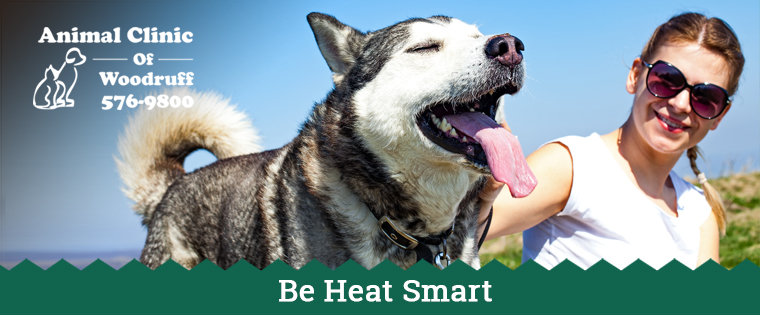Spartanburg has four beautiful seasons, and most of us love enjoying the best of each one. In summer, our many hiking trails and extra vacation time call us outdoors, but it’s important to keep everyone safe from one of the downsides of summer: the heat and humidity. As good pet parents, you need to know how to help your dogs stay cool during these long, hot days of summer.
For tips on keeping cats safe in hot weather, read our How to Keep Cats Cool blog.
Which dogs are most at risk of heat problems?
Any dog can get heat exhaustion (or it’s more severe condition, heatstroke), but the dogs most at risk for heat-related illnesses are those that are really young or really old, those that are overweight, the Brachycephalic breeds (those with short/scrunched noses, like pugs and bulldogs, which makes it hard to breathe well and cool down by panting), and those with long, dense coats. If your dog meets several of these criteria (e.g. an older, overweight Pekinese), take special precautions during these hot months.
What can happen when a dog gets too hot?
When humans get hot, we sweat to cool our bodies. While dogs sweat some out of their paws, their main way to cool down is from panting, or rapidly breathing with tongues hanging out. If your dog is not able to keep cool enough just from panting, you may notice these other signs of overheating:
- Excessing panting
- Weakness or lethargy
- Dizziness or walking strangely
- Drooling
- When severe: collapse, convulsions, diarrhea or vomiting
If you see these signs, immediately give your dog cool water, let him/her sit in or swim in water, and call your vet as soon as possible.
The best way to handle heat exhaustion in dogs is to prevent it from happening in the first place.
Tips to prevent dogs from getting overheated:
At home
- Don’t leave dogs outside for long periods of time. Especially in the middle of the day, being outdoors may be too hot for many dogs. If you have to leave a dog outside, make sure he has access to a shaded area and plenty of water.
- Provide cool places in the house for your dog. Ideally, let your dog have access to non-carpeted floors to lie on, or cool parts of an enclosed or dark room. He may also like to be near a fan or an air conditioning vent. If your dog stays in a crate during the day, make sure it’s not in a hot, stuffy room.
- Ensure your dog always has access to fresh, cool water. Change the water more often in summer, and maybe add a few ice cubes to keep it cool.
Outside
- Be car smart. Hot summer temperatures are even more dangerous inside of the car. Don’t leave your dog in a parked car for any amount of time. This chart shows how quickly a warm day can become fatally hot inside a car. If you’re taking your dog for a long ride, take breaks outside of the car at least every two hours, and provide water at each break.
- Save long walks and playtime for mornings and evenings. While your dog certainly still needs bathroom breaks and exercise time, try to schedule these outings during the cooler times in mornings and evenings to avoid the mid-day heat.
- Include extra water breaks on walks, hikes and hunting trips. When venturing outside, take along water that you can share with your dog (bringing a bowl if needed) or stop by streams or lakes so your dog can swim and drink. Also allow your dog to rest in shaded areas during and after long walks.
When you make your plans to explore around Spartanburg, elsewhere in the Upstate or even at the beach, be sure to keep your dog’s health in mind. A little advance planning (bringing water, finding shade, taking car breaks) can ensure your dog is healthy and happy all summer.
If you have questions about summer plans with your dogs, make an appointment with the helpful vets at Animal Clinic of Woodruff today. And if your dog prefers to avoid the heat and stay inside while you’re out adventuring, we’ll be happy to provide summer dog boarding.













